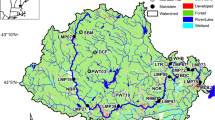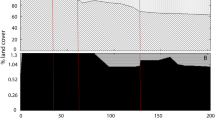Abstract
Dissolved organic carbon (DOC) is the dominant form of carbon in transport in blackwater rivers, and bacteria are the major biological agents of its utilization. This study describes longitudinal patterns in DOC concentration and relates them to suspended bacterial populations in the channel. Concentrations of total DOC, three molecular weight fractions, and bacterial numbers were determined at 12 sites along the Ogeechee River in 1985–1986 and 1989 during periods of low and high discharge. Suspended bacterial populations were compared with DOC concentrations to determine if differences in bacterial abundance were related to longitudinal patterns of DOC concentration. Three distinct longitudinal patterns were observed: (1) The longitudinal pattern followed by both total and intermediate molecular weight DOC concentrations was a linear function of the geographic distance along the river. (2) During low flow conditions, there was a high degree of correspondence between patterns of bacterial numbers and low MW DOC (< 1000 apparent MW). (3) During periods of high discharge, the proportion of high (> 10,000) and intermediate (1000–10,000) MW fractions increased, and there was no longer a clear relationship between bacterial cells and low MW DOC.
Similar content being viewed by others
References
Beck KC, Reuter JH & Perdue EM (1974) Organic and inorganic geochemistry of some Coastal Plain rivers of the southeastern United States. Geochim. Cosmochim. Acta 38: 341–364
Benke AC & Meyer JL (1988) Structure and function of a blackwater river in the southeastern U.S.A. Verh. Int. Ver. Theor. Ang. Limn. 23: 1209–1218
Benke AC & Wallace JB (1990) Wood dynamics in Coastal Plain blackwater streams. Canadian Journal of Fisheries and Aquatic Sciences 47: 92–99
Bratbak G (1985) Bacterial biovolume and biomass estimations. Appl. Environ. Microbiol. 49: 1488–1493
Carlough LA (1989) Sestonic protists in the foodweb of a southeastern blackwater river. Ph.D. Dissertation. University of Georgia, Athens. 173 p
Cuffney TF (1988) Input, movement and exchange of organic matter within a subtropical coastal blackwater river-floodplain system. Freshwater Biology 19: 305–320
Dahm CN (1981) Pathways and mechanisms for removal of dissolved organic carbon from leaf leachate in streams. Can. J. Fish. Aquat. Sci. 38: 68–76
Edwards RT (1987) Sestonic bacteria as a food source for filtering invertebrates in two southeastern blackwater rivers. Limnol. Oceanogr. 32: 221–234
Edwards RT & Meyer JL (1987) Metabolism of a subtropical low gradient blackwater river. Freshwater Biology 17: 251–263
Edwards RT, Meyer JL & Findlay SEG (1990) The relative contribution of benthic and suspended bacteria to system biomass, production, and metabolism in a low-gradient blackwater river. Journal of the North American Benthological Society 9: 216–228
Ertel JR, Hedges JI, Devol AH & Richey (1986) Dissolved humic substances of the Amazon River system. Limnology and Oceanography 31: 739–754
Ford TE & Lock MA (1985) A temporal study of colloidal and dissolved organic carbon in rivers: apparent molecular weight spectra and their relationship to bacterial activity. Oikos 45: 71–78
Freeman C & Lock MA (1992) Recalcitrant high-molecular-weight material, an inhibitor of microbial metabolism in river biofilms. Appl. and Environ. Microbiol. 58: 2030–2033
Hobbie JE & Likens GE (1973) Output of phosphorus, dissolved organic carbon, and fine particulate carbon from Hubbard Brook watersheds. Limnol. Oceanogr. 18: 734–742
Hobbie JE, Daley RJ & Jasper S (1977) Use of Nucleopore filters for counting bacteria by fluorescence nicroscopy. Appl. Environ. Microbio. 33: 1225–1228
Hodler TW & Shretter HA (1986) The Atlas of Georgia. University of Georgia, Institute of Community and Area Development, Athens
Johnson NM, Driscoll CT, Eaton JS, Likens GE & McDowell WH (1981) ‘Acid rain,’ dissolved aluminium and chemical weathering at the Hubbard Brook Experimental Forest, New Hampshire. Geochim. Cosmochim. Acta. 45: 1421–1437
Kaplan LA, Larson RA & Bott TL (1980) Patterns of dissolved organic carbon in transport. Limnol. Oceanogr. 25: 1034–1043
Kaplan LA & Bott TL (1982) Diel fluctuations of DOC generated by algae in a piedmont stream. Limnol. Oceanogr. 27: 1091–1100
Kaplan LA & Bott TL (1983) Microbial heterotrophic utilization of dissolved organic matter in a piedmont stream. Freshwater Biology 13: 363–377
Ladd TI, Ventullo RM, Wallis PM & Costerton JW (1982) Heterotrophic activity and biodegradation of labile and refractory compounds by groundwater and stream microbial populations. Appl. Environ. Microbiol. 44: 321–329
Leff LG & Meyer JL (1991) Biological availability of dissolved organic carbon along the Ogeechee River. Limnol. Oceanogr. 36: 315–323
Lock MA & Ford TE (1985) Microcalorimetric approach to determine relationships between energy supply and metabolism in river epilithon. Appl. Environ. Microbiol. 49: 408–412
Malcolm RL & Durum WH (1976) Organic carbon and nitrogen concentrations and annual organic carbon load of six selected rivers of the United States. U.S. Geol. Surv. Water-Supply Pap. 1817-F. 21 pp
McDowell WH & Likes GE (1988) Origin, composition, and flux of dissolved organic carbon in the Hubbard brook valley. Ecol. Monogr. 58: 177–195
Meyer JL (1986) Dissolved organic carbon dynamics in two subtropical blackwater rivers. Arch. Hydrobiol. 108: 119–134
Meyer JL (1990a) A blackwater perspective on riverine ecosystems. BioScience 40: 643–651
Meyer JL (1990b) Production and utilization of dissolved organic carbon in riverine ecosystems. In: Perdue E & Gjessing ET (Eds) Organic Acids in Aquatic Ecosystems (pp 281–300). John Wiley & Sons
Meyer JL & Edwards RT (1990) Community metabolism along a blackwater river continuum. Ecology 71: 668–677
Meyer JL, Edwards RT & Risley R (1987) Bacterial growth on dissolved organic carbon from a blackwater river. Microb. Ecol. 13: 13–29
Meyer JL & Tate CM (1983) The effects of watershed disturbance on dissolved organic carbon dynamics of a streams. Ecology 64: 33–44
Meyer JL, Tate CM, Edwards RT & Crocker MT (1988) The trophic significance of dissolved organic carbon in streams. In: Swank WT & Crossley DT (Eds) Forest Hydrology and Ecology at Coweeta (pp 269–278). Springer
Moeller JR, Minshall GW, Cummins RC, Cushing CE, Sedell JR, Larson RA & Vannote (1979) Transport of dissolved organic carbon in streams of differing physiographic characteristics. Org. Geochem. 1: 139–150
Moore RM, Burton JD, Williams PJ & Young ML (1979) The behaviour of dissolved organic material, iron and manganese in estuarine mixing. Geochim. Cosmochim. Acta 43: 919–926
Naiman RJ (1982) Characteristics of sediment and organic carbon export from pristine boreal forest watersheds. Can. J. Fish. Aquat. Sci. 39: 1699–1718
Pomeroy LR (1974) The ocean's food web, a changing paradigm. BioScience 24: 499–504
Pulliam WM (1991) Carbon dioxide and methane exports from a southeastern floodplain swamp: Patterns, pathways and sensitivities to climate. PhD. Dissertation. University of Georgia, Athens
Sabater F, Armengol J & Sabater F (1989) Measuring discontinuities in the Ter River. Regulated Rivers: Research and Management 3: 133–142
Servais P (1989) Bacterioplanktonic biomass and production in the river Meuse (Belgium). Hydrobiologia 174: 99–100
St. John TV & Anderson AB (1982) A re-examination of plant phenolics as a source of tropical blackwater rivers. Trop. Ecol. 23: 151–154
Vannote RL, Minshall GW, Cummins KW, Sedell JR & Cushing CE (1980) The river continuum concept. Can. J. Fish. Aquat. Sci. 37: 130–137
Wallace JB, Ross DB & Meyer JL (1982) Seston and dissolved organic carbon dynamics in a southern Appalachian stream. Ecology 63: 824–838
Wallace JB & Benke AC (1984) Quantification of wood habitat in subtropical Coastal Plain streams. Can. J. Fish. Aquat. Sci. 41: 1643–1652
Wetzel RG & Manny BA (1972) Decomposition of dissolved organic carbon and nitrogen compounds from leaves in an experimental hardwater stream. Limnol. Oceanogr: 17: 927–931
Wetzel RG & Manny BA (1977) Seasonal changes in particulate and dissolved organic carbon and nitrogen in a hardwater stream. Arch. Hydrobiol. 80: 20–30
Author information
Authors and Affiliations
Rights and permissions
About this article
Cite this article
Sabater, F., Meyer, J.L. & Edwards, R.T. Longitudinal patterns of dissolved organic carbon concentration and suspended bacterial density along a blackwater river. Biogeochemistry 21, 73–93 (1993). https://doi.org/10.1007/BF00000872
Received:
Accepted:
Issue Date:
DOI: https://doi.org/10.1007/BF00000872




